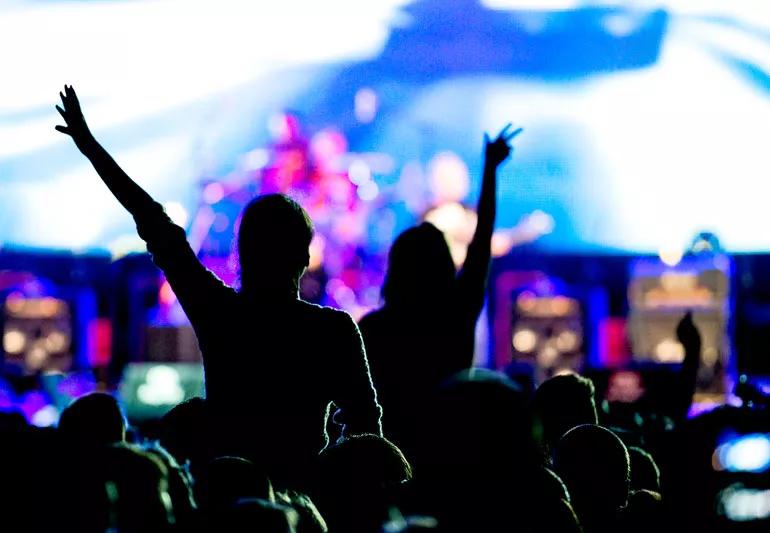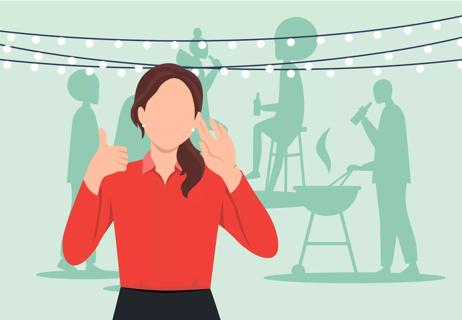Ringing is already a sign of damage, but you can take steps to keep your hearing protected

When you come out of a loud concert with ringing ears, you likely chalk it up to part of the experience. Over the next few days, you’ll wait for the sensation to fade and then forget about it. Maybe your ears got a workout from all the racket, but they’ll recover fine, right?
Advertisement
Cleveland Clinic is a non-profit academic medical center. Advertising on our site helps support our mission. We do not endorse non-Cleveland Clinic products or services. Policy
The truth is, that feeling in your ears is telling you something — and it’s bad news. It’s a sign you’ve already damaged your hearing.
According to the World Health Organization (WHO) approximately 1.1 billion teens and young adults are at risk for noise-induced hearing loss because of “unsafe use of audio devices … and exposure to damaging levels of sound at noisy entertainment venues such as nightclubs, bars and sporting events.”
No matter how old you are, you need to protect your ears around loud noises to avoid premature hearing loss.
As you get older, it’s common to experience some hearing loss. But that doesn’t mean it’s normal and it’s definitely not something to ignore. Hearing is an important aspect of our overall health that must be protected so it can last a lifetime.
Exposure to loud noise leads to premature hearing loss. That’s 100% preventable, says audiologist Sarah Sydlowski, AuD, PhD.
In fact, having a ringing sensation or dullness in your ears after exposure to loud sounds are signs you have damaged the delicate cells in your inner ear.
“We call this a temporary threshold shift because, with time, your hearing seems to return to normal,” Dr. Sydlowski says. “We now know that there is nothing temporary about it. The damage is permanent. It may not show up on a hearing test, but that damage shows up in your ability to process sounds, especially in noisy environments.”
Advertisement
The damage accumulates over time, too. Every exposure to loud concerts, woodworking tools, motorcycles, hunting, personal listening devices like headphones — they all can add up to irreversible hearing loss. The loss is significant enough to eventually show up on a hearing test and impacts every aspect of your life — from work and relationships to the ability to enjoy social activities.
Tinnitus is a very common issue that’s a sign of damage to your hearing system. You might hear ringing, whistling, clicking and roaring sounds in your ears. These sounds can ebb and flow or be a constant presence in your daily life. Tinnitus can understandably be very frustrating, if not debilitating.
Tinnitus can also be a symptom of certain medical disorders, including Ménière’s disease. But tinnitus is often one of the first symptoms of hearing loss — including hearing loss from exposure to overly loud music and noise.
The louder the sound is, the shorter the amount of time you can safely be around it. It’s a good idea to use ear protection in any situation where the noise level is too loud for too long, Dr. Sydlowski explains. That means at every concert you attend.
“If you have to raise your voice so people can hear you, you’re in a potentially risky sound environment,” she adds. “It also depends on how long you’re exposed to loud noise. If you’re mowing your grass for five minutes, you’re probably safe. However, if you’re mowing grass for two hours, then you’re probably at risk.” Louder sounds — like jet engines and firecrackers — can do damage with even one second of exposure.
The National Institute for Occupational Safety and Health (NIOSH) sets a baseline level of 85 decibels (dB), which is about as loud as city traffic or slightly louder than a garbage disposal. Long exposure above this level can damage the delicate structures inside your ears.
“A majority of people are safe listening to 85 dB for eight hours,” Dr. Sydlowski notes. “Rock concerts are typically 100 dB or higher. At 100 dB, your ears can only tolerate that level for about 15 minutes. Anything longer than that, you should wear hearing protection.”
For starters, you should always wear ear protection when you’re around loud sounds. For example, you should always use hearing protection at all concerts, whether they’re held in an arena or a tiny club. But there are also other ways you can protect your ears from ringing and hearing loss.
This might seem obvious, but standing right next to speakers amplifying loud noises isn’t a good idea. At concerts, don’t park yourself next to the stage to watch a band. If a show is seated, buy tickets farther back. Don’t assume that a smaller venue means a quieter show, either. Even shows in tiny clubs can be loud enough to be damaging.
Your hearing can be damaged by sustained exposure to loud noise anywhere. In other words, keep your radio, music playlists and even TV at a reasonable volume. This is especially true if you’re wearing earbuds or headphones.
Advertisement
Earplugs should fit tightly into your ear canal. They can be used on their own or in combination with hearing protection earmuffs. They come in many shapes, colors and designs. Earplugs are also light and easy to carry around, making them a good option for concerts.
Earplugs also offer good protection for a loud workplace such as a factory, construction site or airport, according to Dr. Sydlowski.
But the challenge with earplugs is trying to find the ones that fit into your ears easily, comfortably and appropriately. It’s important to understand that they must be inserted correctly in order to be effective.
“The fit is critical,” Dr. Sydlowski states. “Try different earplugs to find an earplug that feels comfortable and provides you the best sound reduction.”
If you’re around loud sounds often, you can also be fitted for custom earplugs that are professional-grade. If you’re a musician, there are special filters that can be included to allow the sounds you need to hear through. See an audiologist for custom earplugs.
Like the fluffy headgear designed to protect your outer ears from the cold, earmuffs designed for hearing protection are easy to fit and simply slip on over your head.
But earmuffs for hearing protection are serious pieces of equipment, usually with broad foam-cushioned cups that go over the ears to block out sound. Like earplugs, most have a noise reduction rating (NRR), which measures how well the equipment protects your hearing. The higher the noise reduction rating, the more the earplug or earmuff reduces the sound.
Advertisement
At concerts, you’ll often see little kids wearing earmuffs to protect their tender ears. Children’s ears are smaller, further amplifying loud sounds. But musicians (for example, drummers) might also wear earmuffs or plugs to protect their hearing.
If you need ear protection for recreational noise, earmuffs work well. For instance, use them for:
“The caveat is that they have to fit you properly,” Dr. Sydlowski reiterates. “If there’s any leakage around the cup that fits around your ears then it’s like not wearing ear protection at all.”
With both earplugs and earmuffs, it’s a common misconception that they take away ALL sounds, but they don’t. They simply soften the volume to extend the amount of time you can safely be in the noisy environment.
If you’re not sure if the noise reduction rating (NRR) you’re using is effective, use a sound level meter app on your phone to measure how loud the environment is. Subtract the NRR. If the difference is less than 85 dB, you’re OK. If it’s greater than 85 dB, know that the safe time cuts in half for every 3 dB over 85 dB. For example, 88 dB is safe for four hours, 91 dB for two hours, etc. But don’t forget — the times are cumulative!
Advertisement
If you have ringing in your ears or if your hearing seems muffled, see a healthcare provider or audiologist.
Sudden hearing loss, including hearing loss caused by loud sound exposure, might be able to be treated medically, but usually only if treatment starts within hours or a few days of the loss. Sudden hearing loss is a medical emergency and you should ask to see an audiologist or ear, nose, throat (ENT) physician urgently.
Learn more about our editorial process.
Advertisement

Sudden hearing loss can have many causes — but it’s important to seek treatment fast

Hearing aids can be enough for some people, but other devices — like for your phone, TV and fire alarm — can help, too

Untreated hearing loss can affect kids’ speech and language development and their overall quality of life

Reduce background noise, don’t talk too fast or too slow and above all, ask what’s most helpful to them

COVID-19 may be associated with tinnitus, but research is still ongoing

There are lots of tips, tricks and assistive devices out there that can help

Keeping your brain healthy is key

Understand the symptoms and find relief

Start having sex about 72 hours before ovulation, then at least every other day during your fertile window

Attachment theory suggests that your earliest relationships shape connections throughout your life

It isn’t a recognized mental health disorder, but research shows that problematic social media use can negatively affect your mental health, self-esteem and sleep